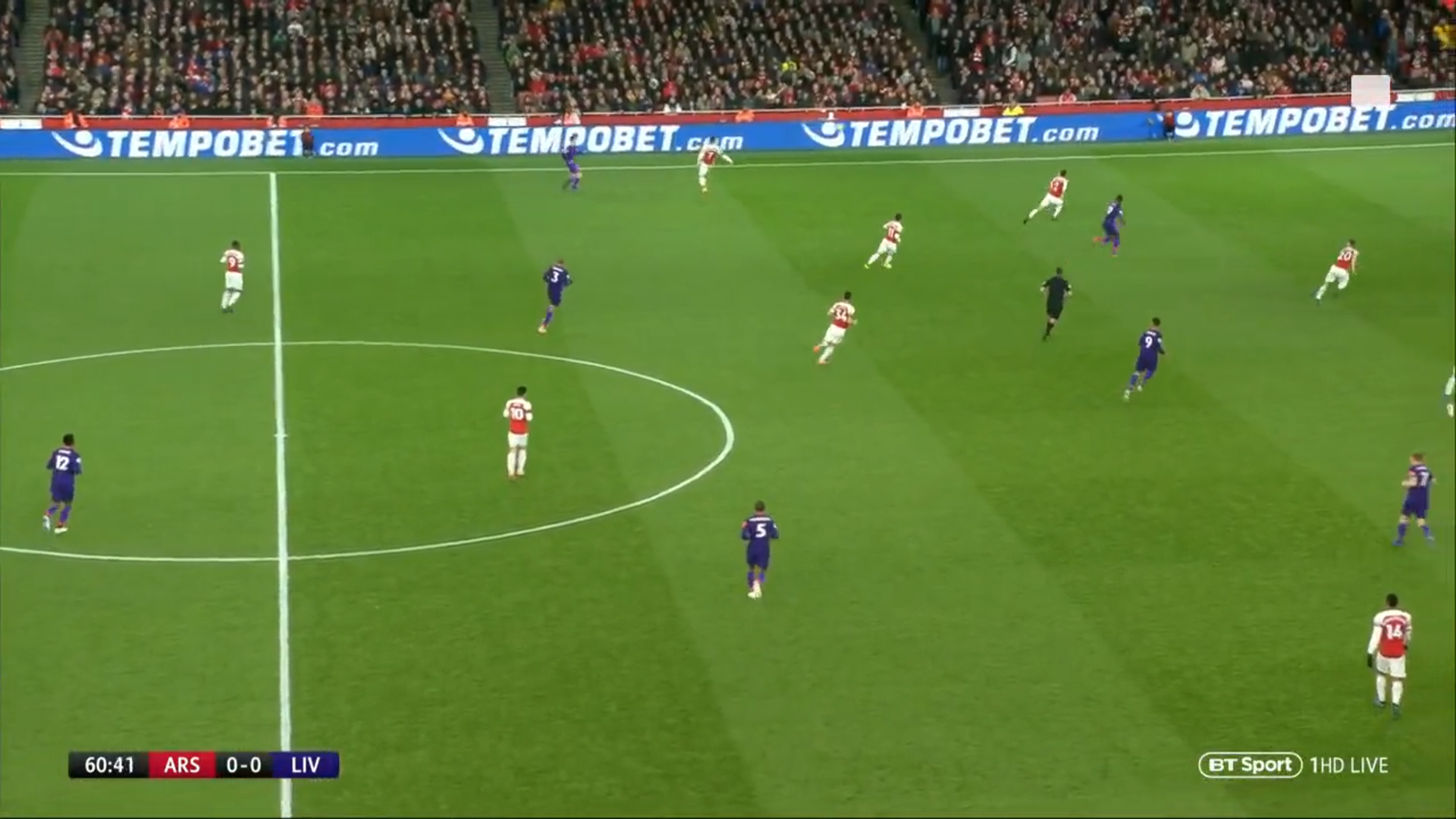Pre-game:
Watching Emery’s first season at Arsenal, it is clear that he opts to play out from defence to build attacks. This is facilitated by the passing options available to the keeper with the centre backs split, the defensive midfielders dropping deep and wingers operating in the half spaces. Going into the game it was interesting to see if Liverpool would seek to pressure the Arsenal players who are not entirely comfortable on the ball (i.e. Mustafi, Holding, Xhaka etc).

As can be seen by the above diagram, Arsenal’s team shape features some horizontal solidity which aids the progression of play both out wide and through the middle. The width of Arsenal’s full-backs allows wingers to come inside slightly, link up with the #10 and operate between defensive and midfield lines. This causes uncertainty for most defences as opposition fullbacks are either caught on the break (leaving space behind them) or the opposition attempts to flood the channels by marking Arsenal’s wide men which vacates space centrally for play to progress through the two #6s and #10.
Another interesting prospect leading into the game was the performance of Fabinho, considering his delayed introduction to Liverpool’s first-team. After a relatively untested afternoon against Cardiff on his first Premier League start, his performance at the Emirates is what fans are more likely to remember so it is imperative that he steps up. As Arsenal like to operate a thorough counter-press, it will also be interesting to see if Fabinho and the rest of the Liverpool midfield can deal with Arsenal’s pressure – this is perhaps what the midfield battle will be won and lost on.
However, with Arsenal winless against Liverpool in their last six Premier League meetings before this game, it seemed as though Arsenal would surrender their unbeaten run to a rampant Liverpool side.
But this was not at all the case.
Game: 1st half
Early in the first half, Aubameyang, Ozil, Lacazette & Mkhitaryan all appeared to be operating between the lines but astute defending from Van Dijk and Gomez keeps it goalless.

As the half went on, Liverpool were seeing how difficult it was to build through Emery’s compactly built side and opted for long balls into right-hand channel for Salah to chase, exploiting the gaps between Holding and Kolasinac, as the latter sought to bomb forward.
In this Emery system, there is a lot of pressure on the tenacious Lucas Torreira to give much needed defensive cover to Holding and Mustafi with his aggressive ball-winning abilities and forward bursts to commence attacking phases of play. However, if Torreira loses possession or his concentration, the opposition are presented with a near golden chance at Arsenal’s goal, as can be seen below.

After Torreira ceded possession in his own half attempting to build from the back.

Torreira caught ball-watching and misses the run of Firmino ahead of him, leading to Mane’s disallowed goal.
Both teams opt to play out of the back but both teams also seek to press the opposing back line. Yet Arsenal made it harder for Liverpool to pass out as they had four players pressing, as opposed to Liverpool’s front three. At times, this proved difficult for the likes of Gomez and Robertson, who are not the worst defenders on the ball by any stretch.
It looked as though Liverpool’s midfield three all had offensive and defensive duties such as covering the overlapping full-backs and supporting counter attacks. But this caused problems for Liverpool as it left space between the midfield and defenders. Whereas, with Arsenal’s midfield, Xhaka and Torreira opted to sit deeper and progress play either through the full backs, wingers or Ozil. This gave Arsenal’s front four greater attacking freedom to exploit the space behind Liverpool’s midfield.

Ozil receives the ball from Xhaka between the lines, who flicks the ball into Lacazette, putting him through on goal.
As Liverpool’s midfield three operated mainly as box-to-box midfielders, they left too much space between themselves and the rest of the team in transitions. This meant much of Liverpool’s attacks came to nothing due to a lack of midfield support and Arsenal being able to transition well in attack as Liverpool’s midfield attempt to drop back.
2nd half:
In the first few minutes of the second half, you can see that Klopp decided to replicate Arsenal’s 4-2-3-1 formation, with Milner on the right, Fabinho & Wijnaldum holding, Firmino at #10 and Salah up front. My assumption is that this was to stop the turnovers in midfield and to give less of an attacking onus to Fabinho and Wijnaldum, who struggled to impact the game in the first half.
A good chance for Arsenal comes from Fabinho’s perpetual lack of awareness, as Lacazette drops deep, which drags out Van Dijk, leaving space between Gomez and Robertson for Mkhitaryan to run into. If Fabinho was aware of Lacazette dropping deeper, he should have cut passing options to him whilst holding his position, allowing Van Dijk to hold his defensive line. Fortunately for Fabinho, Mkhitaryan fluffed his lines and the attack came to nothing.

Lacazette dropping deep, dragging Van Dijk with him.

Fabinho is caught ball-watching instead of helping Van Dijk with Lacazette, leaving the defence vulnerable to Mkhitaryan’s run.

Mkhitaryan played through by Bellerin, with the perfect opportunity for Mkhi to square it to Aubameyang.
Despite Liverpool’s formation change, they still struggled to play through Arsenal. Liverpool’s front three were quite stagnant as they were outnumbered by Arsenal’s defensive structure. Liverpool still managed to get a goal though, which starts when Mane draws Bellerin by coming short to Robertson, then makes a darting run into the space Bellerin left behind him, getting in behind and putting in a cross which is parried by Leno.

Mane comes deep, which draws out Bellerin out of position.

Mane darts back into Bellerin’s space to put a cross in which is parried by Leno.
The parry ricochets off Holding and falls to Milner who makes it 0-1. This quick passage of play instigated by Mane caught Xhaka and Torreira off-guard as neither managed to pick up Milner on the edge of the box. A lapse in discipline and concentration caused Arsenal to be behind against the run of play.

Milner left unmarked on the edge of Arsenal’s box to make it 0-1.
After their goal, Klopp changed his side’s shape to a variation of 4-4-2, with Firmino & Salah up top and Mane & Milner on the wings. I believe this was to create two deep banks of four to minimise the space in and around their box for Arsenal players to create.
As soon as Aubameyang comes off, both Iwobi and Kolasinac fire in two tantalising crosses with no intended target in the box. These are the chances which Aubameyang perhaps would have finished if he was deployed as a central striker.
As Mane did earlier, Lacazette made a run which exposed the Liverpool CBs, who found it difficult to regroup after Iwobi’s well-timed pass. Gomez, who had a good game, failed to get tighter to Lacazette and Van Dijk appeared to be caught in two minds whether to block on the line or mark Welbeck and ends up doing neither very well.

Lacazette well found by Iwobi, catching the CBs unawares as they try and regroup.

Gomez failing to get tighter to Lacazette, while Welbeck occupies Van Dijk on the line.
Late on in the game, an off-the-ball run by Ramsey occupies both Van Dijk and Gomez, which left space for Lacazette to run into. Welbeck lost the ball trying to find Ramsey instead.
After the Arsenal equaliser, both midfields sat deep to avoid being caught on the break. Liverpool had two rigid banks of four, with Wijnaldum playing between lines (to nullify Ramsey or Ozil) and Shaqiri up top with Salah.
Arsenal defended the remainder of the game in a 3-4-3 shape with Iwobi and Ozil as wingbacks. This limited Liverpool’s passing options as the receiver was closed down by two Arsenal players.
Closing remarks
Liverpool lost the midfield battle in 1st half trying to play a three, all with attacking and defensive functions. Fabinho was hounded out of possession by Arsenal’s imposing press and compact team shape.
As a result, Arsenal were better in transition from defence to attack with the aid of their front four and full-backs, in comparison to Liverpool’s front three and midfield who found themselves severed at times. However, there were occasions where Arsenal were caught unexpectedly by Liverpool’s attacking runs as Liverpool’s goal shows.
Overall, it was a promising performance from Arsenal considering the major tactic shift this season against a traditionally clinical Liverpool side.
My final assumption on the game is that Liverpool’s chances were borne out of individual moments (like Mane’s run, Van Dijk’s aerial presence) whereas Arsenal’s chances reflected a well-drilled team where every player knew where they needed to be in each phase of play.
